™
Future Technology Devices International Ltd.
FT245R USB FIFO I.C.
Incorporating FTDIChip-ID™ Security Dongle
The FT245R is the latest device to be added to FTDI’s range of USB FIFO interface Integrated Circuit Devices.
The FT245R is a USB to parallel FIFO interface, with the new FTDIChip-ID™ security dongle feature. In addition,
asynchronous and synchronous bit bang interface modes are available. USB to parallel designs using the FT245R
have been further simplified by fully integrating the external EEPROM, clock circuit and USB resistors onto the device.
The FT245R adds a new function compared with its predecessors, effectively making it a “2-in-1” chip for some
application areas. A unique number (the FTDIChip-ID™) is burnt into the device during manufacture and is readable
over USB, thus forming the basis of a security dongle which can be used to protect customer application software
from being copied.
The FT245R is available in Pb-free (RoHS compliant) compact 28-Lead SSOP and QFN-32 packages.
Copyright © Future Technology Devices International Ltd. 2005
�
1. Features
•
1.1 Hardware Features
Single chip USB to parallel FIFO bidirectional data
transfer interface.
Entire USB protocol handled on the chip - No
USB-specific firmware programming required.
Simple interface to MCU / PLD / FPGA logic with
simple 4-wire handshake interface.
Data transfer rate to 1 Megabyte / second - D2XX
Direct Drivers.
Data transfer rate to 300 kilobyte / second - VCP
Drivers.
256 byte receive buffer and 128 byte transmit
buffer utilising buffer smoothing technology to allow
for high data throughput.
FTDI’s royalty-free VCP and D2XX drivers
eliminate the requirement for USB driver
development in most cases.
New USB FTDIChip-ID™ feature.
FIFO receive and transmit buffers for high data
throughput.
Adjustable receive buffer timeout.
Synchronous and asynchronous bit bang mode
interface options with RD# and WR# strobes allow
the data bus to be used as a general purpose I/O
port.
Integrated 1024 Bit internal EEPROM for storing
USB VID, PID, serial number and product
description strings.
Device supplied preprogrammed with unique USB
serial number.
•
•
•
•
•
•
•
•
•
•
•
•
1.2 Driver Support
Royalty-Free VIRTUAL COM PORT
(VCP) DRIVERS for...
•
•
•
•
•
•
•
Windows 98, 98SE, ME, 2000, Server 2003, XP.
Windows Vista / Longhorn*
Windows XP 64-bit.*
Windows XP Embedded.
Windows CE.NET 4.2 & 5.0
MAC OS 8 / 9, OS-X
Linux 2.4 and greater
Page 2
•
•
•
•
•
•
•
•
•
•
•
•
•
•
•
•
•
•
•
Support for USB suspend / resume through
PWREN# pin and Wake Up pin function.
In-built support for event characters.
Support for bus powered, self powered, and high-
power bus powered USB configurations.
Integrated 3.3V level converter for USB I/O .
Integrated level converter on FIFO interface and
control pins for interfacing to 5V - 1.8V Logic.
True 5V / 3.3V / 2.8V / 1.8V CMOS drive output
and TTL input.
High I/O pin output drive option.
Integrated USB resistors.
Integrated power-on-reset circuit.
Fully integrated clock - no external crystal,
oscillator, or resonator required.
Fully integrated AVCC supply filtering - No separate
AVCC pin and no external R-C filter required.
USB bulk transfer mode.
3.3V to 5.25V Single Supply Operation.
Low operating and USB suspend current.
Low USB bandwidth consumption.
UHCI / OHCI / EHCI host controller compatible
USB 2.0 Full Speed compatible.
-40°C to 85°C extended operating temperature
range.
Available in compact Pb-free 28 Pin SSOP and
QFN-32 packages (both RoHS compliant).
Royalty-Free D2XX Direct Drivers
(USB Drivers + DLL S/W Interface)
•
•
•
•
•
•
Windows 98, 98SE, ME, 2000, Server 2003, XP.
Windows Vista / Longhorn*
Windows XP 64-bit.*
Windows XP Embedded.
Windows CE.NET 4.2 & 5.0
Linux 2.4 and greater
The drivers listed above are all available to download for free from the FTDI website. Various 3rd Party Drivers are
also available for various other operating systems - see the FTDI website for details.
* Currently Under Development. Contact FTDI for availability.
•
•
•
•
•
•
•
•
1.3 Typical Applications
Upgrading Legacy Peripherals to USB
Cellular and Cordless Phone USB data transfer
cables and interfaces
Interfacing MCU / PLD / FPGA based designs to
USB
USB Audio and Low Bandwidth Video data transfer
PDA to USB data transfer
USB Smart Card Readers
USB Instrumentation
USB Industrial Control
•
•
•
•
•
•
•
•
USB MP3 Player Interface
USB FLASH Card Reader / Writers
Set Top Box PC - USB interface
USB Digital Camera Interface
USB Hardware Modems
USB Wireless Modems
USB Bar Code Readers
USB Software / Hardware Encryption Dongles
FT245R USB UART I.C. Datasheet Version 1.05
© Future Technology Devices International Ltd. 2005
�
2. Enhancements
2.1 Device Enhancements and Key Features
Page 3
This section summarises the enhancements and the key features of the FT245R device. For further details, consult
the device pin-out description and functional description sections.
Integrated Clock Circuit - Previous generations of FTDI’s USB to parallel FIFO interface devices required an external
crystal or ceramic resonator. The clock circuit has now been integrated onto the device meaning that no crystal or
ceramic resonator is required. However, if required, an external 12MHz crystal can be used as the clock source.
Integrated EEPROM - Previous generations of FTDI’s USB to parallel FIFO interface devices required an external
EEPROM if the device were to use USB Vendor ID (VID), Product ID (PID), serial number and product description
strings other than the default values in the device itself. This external EEPROM has now been integrated onto the
FT245R chip meaning that all designs have the option to change the product description strings. A user area of the
internal EEPROM is available for storing additional data. The internal EEPROM is programmable in circuit, over USB
without any additional voltage requirement.
Preprogrammed EEPROM - The FT245R is supplied with its internal EEPROM preprogrammed with a serial number
which is unique to each individual device. This, in most cases, will remove the need to program the device EEPROM.
Integrated USB Resistors - Previous generations of FTDI’s USB to parallel FIFO interface devices required two
external series resistors on the USBDP and USBDM lines, and a 1.5 kΩ pull up resistor on USBDP. These three
resistors have now been integrated onto the device.
Integrated AVCC Filtering - Previous generations of FTDI’s USB to parallel FIFO interface devices had a separate
AVCC pin - the supply to the internal PLL. This pin required an external R-C filter. The separate AVCC pin is now
connected internally to VCC, and the filter has now been integrated onto the chip.
Less External Components - Integration of the crystal, EEPROM, USB resistors, and AVCC filter will substantially
reduce the bill of materials cost for USB interface designs using the FT245R compared to its FT245BM predecessor.
Transmit and Receive Buffer Smoothing - The FT245R’s 256 byte receive buffer and 128 byte transmit buffer utilise
new buffer smoothing technology to allow for high data throughput.
Enhanced Asynchronous Bit Bang Mode with RD# and WR# Strobes - The FT245R supports FTDI’s BM chip bit
bang mode. In bit bang mode, the eight parallel FIFO data bus lines can be switched from the regular interface mode
to an 8-bit general purpose I/O port. Data packets can be sent to the device and they will be sequentially sent to the
interface at a rate controlled by an internal timer (equivalent to the baud rate prescaler). With the FT245R device this
mode has been enhanced so that the internal RD# and WR# strobes are now brought out of the device which can be
used to allow external logic to be clocked by accesses to the bit bang I/O bus. This option will be described more fully
in a separate application note
Synchronous Bit Bang Mode - Synchronous bit bang mode differs from asynchronous bit bang mode in that the
interface pins are only read when the device is written to. Thus making it easier for the controlling program to measure
the response to an output stimulus as the data returned is synchronous to the output data. The feature was previously
seen in FTDI’s FT2232C device. This option will be described more fully in a separate application note.
Lower Supply Voltage - Previous generations of the chip required 5V supply on the VCC pin. The FT245R will work
with a Vcc supply in the range 3.3V - 5V. Bus powered designs would still take their supply from the 5V on the USB
bus, but for self powered designs where only 3.3V is available, and there is no 5V supply, there is no longer any need
for an additional external regulator.
Integrated Level Converter on FIFO Interface and Control Signals - VCCIO pin supply can be from 1.8V to 5V.
Connecting the VCCIO pin to 1.8V, 2.8V, or 3.3V allows the device to directly interface to 1.8V, 2.8V or 3.3V and other
logic families without the need for external level converter I.C.s
5V / 3.3V / 2.8V / 1.8V Logic Interface - The FT245R provides true CMOS Drive Outputs and TTL level Inputs.
FT245R USB UART I.C. Datasheet Version 1.05
© Future Technology Devices International Ltd. 2005
�
Page 4
Integrated Power-On-Reset (POR) Circuit- The device incorporates an internal POR function. A RESET# pin is
available in order to allow external logic to reset the FT245R where required. However, for many applications the
RESET# pin can be left unconnected, or pulled up to VCCIO.
Wake Up Function - If USB is in suspend mode, and remote wake up has been enabled in the internal EEPROM (it is
enabled by default), the RXF# pin becomes an input. Strobing this pin low will cause the FT245R to request a resume
from suspend on the USB bus. Normally this can be used to wake up the host PC from suspend
Lower Operating and Suspend Current - The device operating supply current has been further reduced to 15mA,
and the suspend current has been reduced to around 70μA. This allows a greater margin for peripherals to meet the
USB suspend current limit of 500μA.
Low USB Bandwidth Consumption - The operation of the USB interface to the FT245R has been designed to use
as little as possible of the total USB bandwidth available from the USB host controller.
High Output Drive Option - The parallel FIFO interface and the four FIFO handshake pins can be made to drive
out at three times the standard signal drive level thus allowing multiple devices to be driven, or devices that require a
greater signal drive strength to be interfaced to the FT245R. This option is configured in the internal EEPROM.
Power Management Control for USB Bus Powered, High Current Designs- The PWREN# signal can be used to
directly drive a transistor or P-Channel MOSFET in applications where power switching of external circuitry is required.
An option in the internal EEPROM makes the device gently pull down on its FIFO interface lines when the power
is shut off (PWREN# is high). In this mode any residual voltage on external circuitry is bled to GND when power is
removed, thus ensuring that external circuitry controlled by PWREN# resets reliably when power is restored.
FTDIChip-ID™ - Each FT245R is assigned a unique number which is burnt into the device at manufacture. This ID
number cannot be reprogrammed by product manufacturers or end-users. This allows the possibility of using FT245R
based dongles for software licensing. Further to this, a renewable license scheme can be implemented based on the
FTDIChip-ID™ number when encrypted with other information. This encrypted number can be stored in the user area
of the FT245R internal EEPROM, and can be decrypted, then compared with the protected FTDIChip-ID™ to verify
that a license is valid. Web based applications can be used to maintain product licensing this way. An application note
describing this feature is available separately from the FTDI website.
Improved EMI Performance - The reduced operating current and improved on-chip VCC decoupling significantly
improves the ease of PCB design requirements in order to meet FCC, CE and other EMI related specifications.
Programmable FIFO TX Buffer Timeout - The FIFO TX buffer timeout is used to flush remaining data from the
receive buffer. This timeout defaults to 16ms, but is programmable over USB in 1ms increments from 1ms to 255ms,
thus allowing the device to be optimised for protocols that require fast response times from short data packets.
Extended Operating Temperature Range - The FT232R operates over an extended temperature range of -40º to
+85º C thus allowing the device to be used in automotive and industrial applications.
New Package Options - The FT245R is available in two packages - a compact 28 pin SSOP ( FT245RL) and an
ultra-compact 5mm x 5mm pinless QFN-32 package ( FT245RQ). Both packages are lead ( Pb ) free, and use a
‘green’ compound. Both packages are fully compliant with European Union directive 2002/95/EC.
FT245R USB UART I.C. Datasheet Version 1.05
© Future Technology Devices International Ltd. 2005
�
3. Block Diagram
3.1 Block Diagram (Simplified)
VCC
3V3OUT
USBDP
USBDM
OSCO
(optional)
OCSI
(optional)
TEST
GND
3.3 Volt
LDO
Regulator
USB
Transceiver
with
Integrated
Series
Resistors
and 1.5K
Pull-up
USB DPLL
Internal
12MHz
Oscillator
PWREN#
VCCIO
FIFO TX Buffer
128 bytes
Serial Interface
Engine
( SIE )
USB
Protocol Engine
FIFO Controller
with
Programmable
High Drive
To USB
Transceiver
Cell
Internal
EEPROM
FIFO RX Buffer
256 bytes
3V3OUT
48MHz
Clock
Multiplier
RESET#
RESET
GENERATOR
To USB Transceiver Cell
Page 5
D0
D1
D2
D3
D4
D5
D6
D7
RD#
WR
RXF#
TXE#
Figure 1 - FT245R Block Diagram
3.2 Functional Block Descriptions
3.3V LDO Regulator - The 3.3V LDO Regulator generates the 3.3V reference voltage for driving the USB transceiver
cell output buffers. It requires an external decoupling capacitor to be attached to the 3V3OUT regulator output pin. It
also provides 3.3V power to the 1.5kΩ internal pull up resistor on USBDP. The main function of this block is to power
the USB Transceiver and the Reset Generator Cells, rather than to power external logic. However, external circuitry
requiring 3.3V nominal at a current of around 50mA could also draw its power from the 3V3OUT pin if required.
USB Transceiver - The USB Transceiver Cell provides the USB 1.1 / USB 2.0 full-speed physical interface to the USB
cable. The output drivers provide 3.3V level slew rate control signalling, whilst a differential receiver and two single
ended receivers provide USB data in, SEO and USB Reset condition detection. This Cell also incorporates internal
USB series resistors on the USB data lines, and a 1.5kΩ pull up resistor on USBDP.
USB DPLL - The USB DPLL cell locks on to the incoming NRZI USB data and provides separate recovered clock and
data signals to the SIE block.
Internal 12MHz Oscillator - The Internal 12MHz Oscillator cell generates a 12MHz reference clock input to the x4
Clock multiplier. The 12MHz Oscillator is also used as the reference clock for the SIE, USB Protocol Engine and FIFO
controller blocks
Clock Multiplier - The Clock Multiplier takes the 12MHz input from the Oscillator Cell and generates the 48MHz clock
reference used for the USB DPLL block.
Serial Interface Engine (SIE) - The Serial Interface Engine (SIE) block performs the Parallel to Serial and Serial to
Parallel conversion of the USB data. In accordance to the USB 2.0 specification, it performs bit stuffing / un-stuffing
and CRC5 / CRC16 generation / checking on the USB data stream.
FT245R USB UART I.C. Datasheet Version 1.05
© Future Technology Devices International Ltd. 2005
�
Page 6
USB Protocol Engine - The USB Protocol Engine manages the data stream from the device USB control endpoint. It
handles the low level USB protocol (Chapter 9) requests generated by the USB host controller and the commands for
controlling the functional parameters of the FIFO.
FIFO TX Buffer (128 byte) - Data written into the FIFO using the WR pin is stored in the FIFO TX (transmit) Buffer.
The USB host controller removes data from the FIFO TX Buffer by sending a USB request for data from the device
data In endpoint.
FIFO RX Buffer (256 byte) - Data sent from the USB host controller to the FIFO via the USB data Out endpoint is
stored in the FIFO RX (receive) buffer and is removed from the buffer by reading the contents of the FIFO using the
RD# pin.
FIFO Controller - The FIFO controller handles the transfer of data between the external FIFO interface pins (D0 - D7)
and the FIFO transmit and receive buffers. A new feature, which is enabled in the internal EEPROM allows high signal
drive strength on the FIFO parallel data bus and handshake control pins.
RESET Generator - The integrated Reset Generator Cell provides a reliable power-on reset to the device internal
circuitry on power up. A RESET# input is provided to allow other devices to reset the FT245R. RESET# can be tied
to VCCIO or left unconnected, unless there is a requirement to reset the FT245R device from external logic or an
external reset generator I.C.
Internal EEPROM - The internal EEPROM in the FT245R can be used to store USB Vendor ID (VID), Product ID
(PID), device serial number, product description string, and various other USB configuration descriptors. The device is
supplied with the internal EEPROM settings preprogrammed as described in Section 10.
FT245R USB UART I.C. Datasheet Version 1.05
© Future Technology Devices International Ltd. 2005
�
4. Device Pin Out and Signal Descriptions
4.1 28-LD SSOP Package
Page 7
D0
D4
D2
VCCIO
D1
D7
GND
NC
D5
D6
D3
PWREN#
RD#
WR
Figure 2 - 28 Pin SSOP Package Pin Out
4
20
16
15
8
19
24
27
28
17
1
28
F
T
2
4
5
R
L
Y
Y
X
X
A
F
T
D
-
I
14
15
VCCIO
VCC
USBDM
USBDP
NC
FT245RL
D0
D1
D2
D3
D4
D5
D6
D7
RESET#
NC
OSCI
OSCO
3V3OUT
A
G
N
D
RXF#
TXE#
RD#
WR
PWREN#
G
N
D
G
N
D
G
N
D
T
E
S
T
OSCO
OSCI
TEST
AGND
NC
RXF#
TXE#
GND
VCC
RESET#
GND
3V3OUT
USBDM
USBDP
1
5
3
11
2
9
10
6
23
22
13
14
12
25
7
18
21
26
Figure 3 - 28 Pin SSOP Package Pin Out (Schematic Symbol)
FT245R USB UART I.C. Datasheet Version 1.05
© Future Technology Devices International Ltd. 2005
�
4.2 SSOP-28 Package Signal Descriptions
Page 8
Type Description
Table 1 - SSOP Package Pin Out Description
Pin No. Name
USB Interface Group
I/O
15
16
I/O
Power and Ground Group
4
USBDP
USBDM
VCCIO
7, 18, 21 GND
17
3V3OUT
VCC
AGND
20
25
Miscellaneous Signal Group
8, 24
19
NC
RESET#
26
27
28
TEST
OSCI
OSCO
tor is used.*
FIFO Interface and Control Group
1
2
3
5
6
9
10
11
12
D0
D4
D2
D1
D7
D5
D6
D3
PWREN#
13
14
22
23
RD#
WR
TXE#
RXF#
USB Data Signal Plus, incorporating internal series resistor and 1.5kΩ pull up resistor to 3.3V
USB Data Signal Minus, incorporating internal series resistor.
PWR
+1.8V to +5.25V supply to the FIFO Interface and Control group pins (1...3, 5, 6, 9...14, 22, 23). In USB bus
powered designs connect to 3V3OUT to drive out at 3.3V levels, or connect to VCC to drive out at 5V CMOS
level. This pin can also be supplied with an external 1.8V - 2.8V supply in order to drive out at lower levels. It
should be noted that in this case this supply should originate from the same source as the supply to Vcc. This
means that in bus powered designs a regulator which is supplied by the 5V on the USB bus should be used.
Device ground supply pins
PWR
Output 3.3V output from integrated L.D.O. regulator. This pin should be decoupled to ground using a 100nF capacitor.
The prime purpose of this pin is to provide the internal 3.3V supply to the USB transceiver cell and the internal
1.5kΩ pull up resistor on USBDP. Up to 50mA can be drawn from this pin to power external logic if required.
This pin can also be used to supply the FT245R’s VCCIO pin.
3.3V to 5.25V supply to the device core.
Device analog ground supply for internal clock multiplier
PWR
PWR
NC
Input
No internal connection.
Can be used by an external device to reset the FT245R. If not required can be left unconnected or pulled up
to VCCIO.
Puts the device into I.C. test mode. Must be grounded for normal operation.
Input to 12MHz Oscillator Cell. Optional - Can be left unconnected for normal operation. *
Input
Input
Output Output from 12MHz Oscillator Cell. Optional - Can be left unconnected for normal operation if internal oscilla-
FIFO Data Bus Bit 0**
FIFO Data Bus Bit 4**
FIFO Data Bus Bit 2**
FIFO Data Bus Bit 1**
FIFO Data Bus Bit 7**
FIFO Data Bus Bit 5**
FIFO Data Bus Bit 6**
FIFO Data Bus Bit 3**
I/O
I/O
I/O
I/O
I/O
I/O
I/O
I/O
Output Goes low after the device is configured by USB, then high during USB suspend. Can be used to control power
to external logic P-Channel logic level MOSFET switch. Enable the interface pull-down option when using the
PWREN# pin in this way.
Enables the current FIFO data byte on D0...D7 when low. Fetched the next FIFO data byte (if available) from
the receive FIFO buffer when RD# goes from high to low. See Section 4.5 for timing diagram. **
Input
Input Writes the data byte on the D0...D7 pins into the transmit FIFO buffer when WR goes from high to low. See
Section 4.5 for timing diagram. **
Output When high, do not write data into the FIFO. When low, data can be written into the FIFO by strobing WR high,
then low. During reset this signal pin is tri-state, but pulled up to VCCIO via an internal 200kΩ resistor. See
Section 4.5 for timing diagram.
Output When high, do not read data from the FIFO. When low, there is data available in the FIFO which can be read
by strobing RD# low, then high again. During reset this signal pin is tri-state, but pulled up to VCCIO via an
internal 200kΩ resistor. See Section 4.5 for timing diagram.
If the Remote Wakeup option is enabled in the internal EEPROM, during USB suspend mode (PWREN# = 1)
RXF# becomes an input which can be used to wake up the USB host from suspend mode. Strobing the pin
low will cause the device to request a resume on the USB bus.
*Contact FTDI Support for details of how to use an external crystal, ceramic resonator, or oscillator with the FT245R.
** When used in Input Mode, these pins are pulled to VCCIO via internal 200kΩ resistors. These can be programmed
to gently pull low during USB suspend ( PWREN# = “1” ) by setting this option in the internal EEPROM.
FT245R USB UART I.C. Datasheet Version 1.05
© Future Technology Devices International Ltd. 2005
�
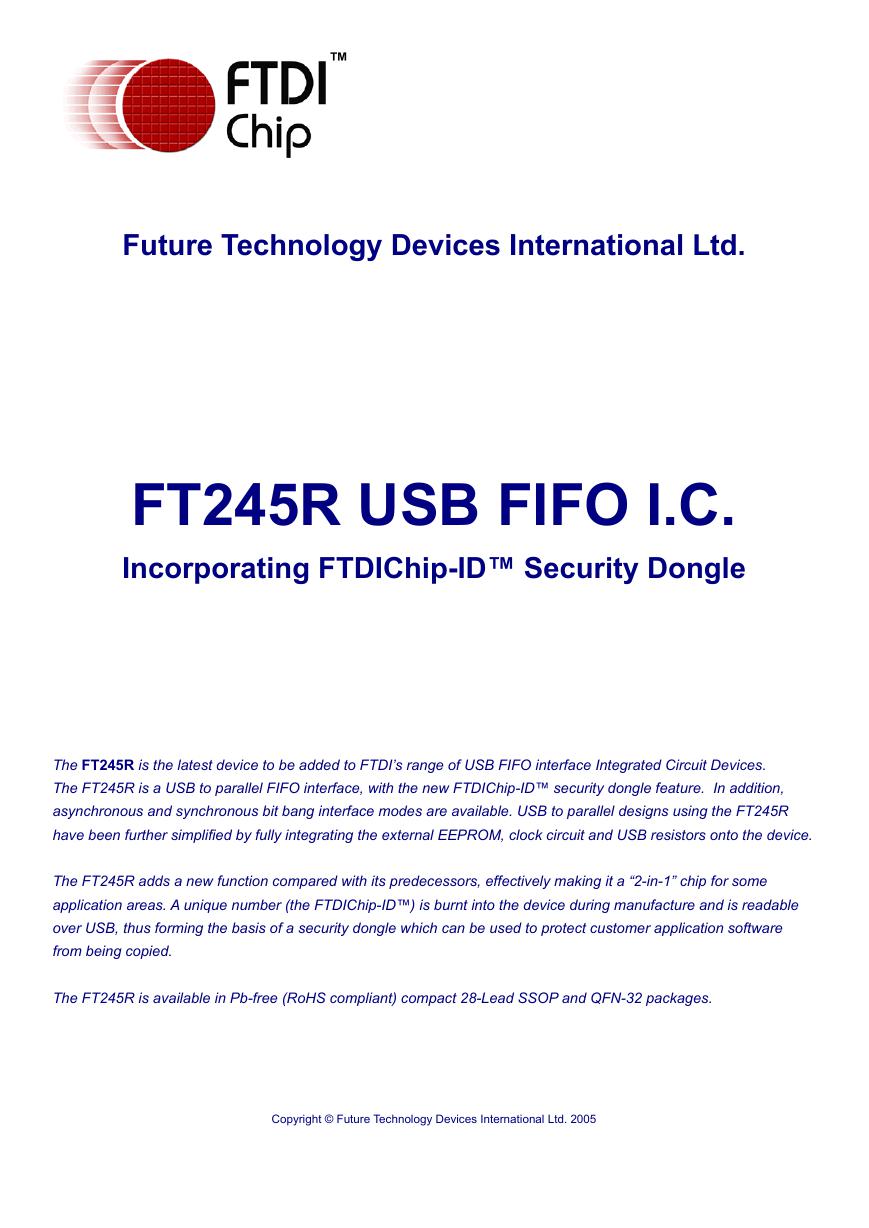

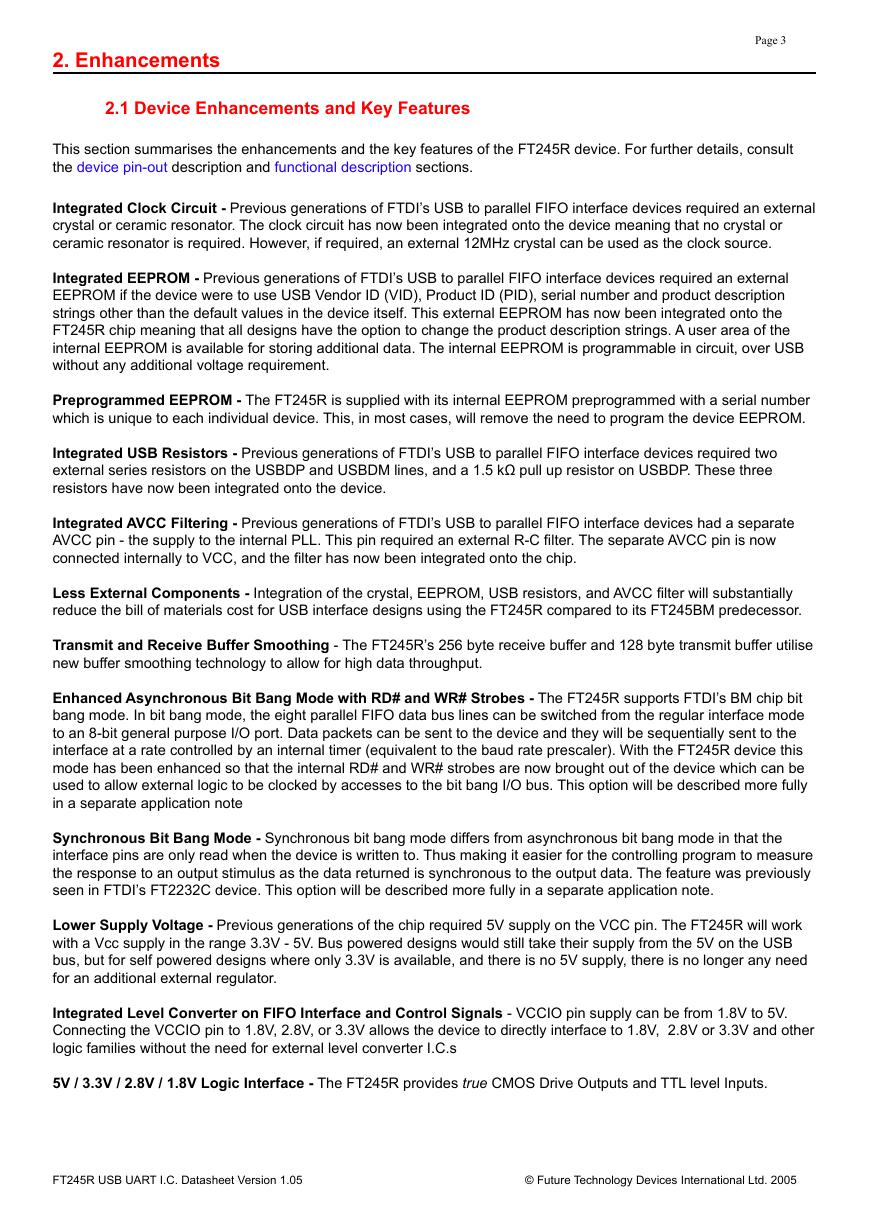
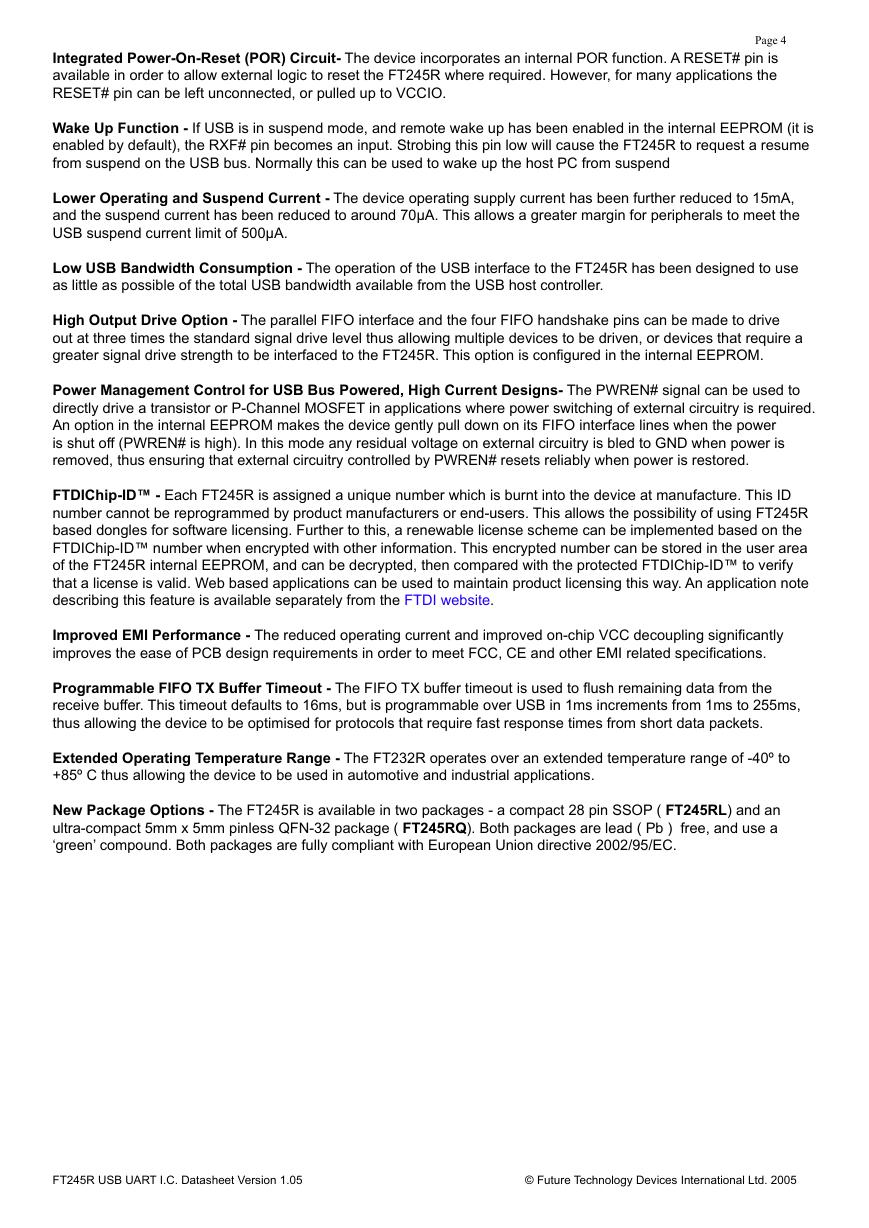

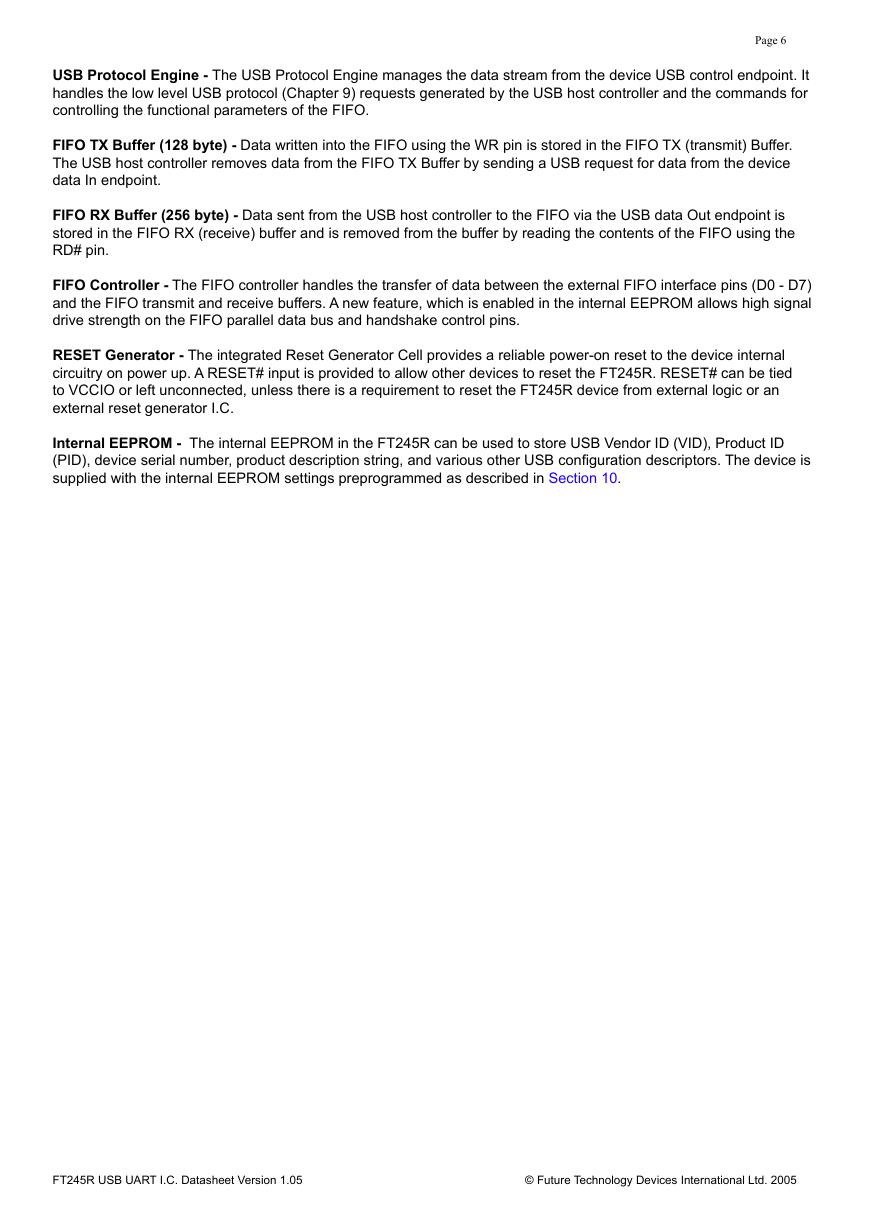
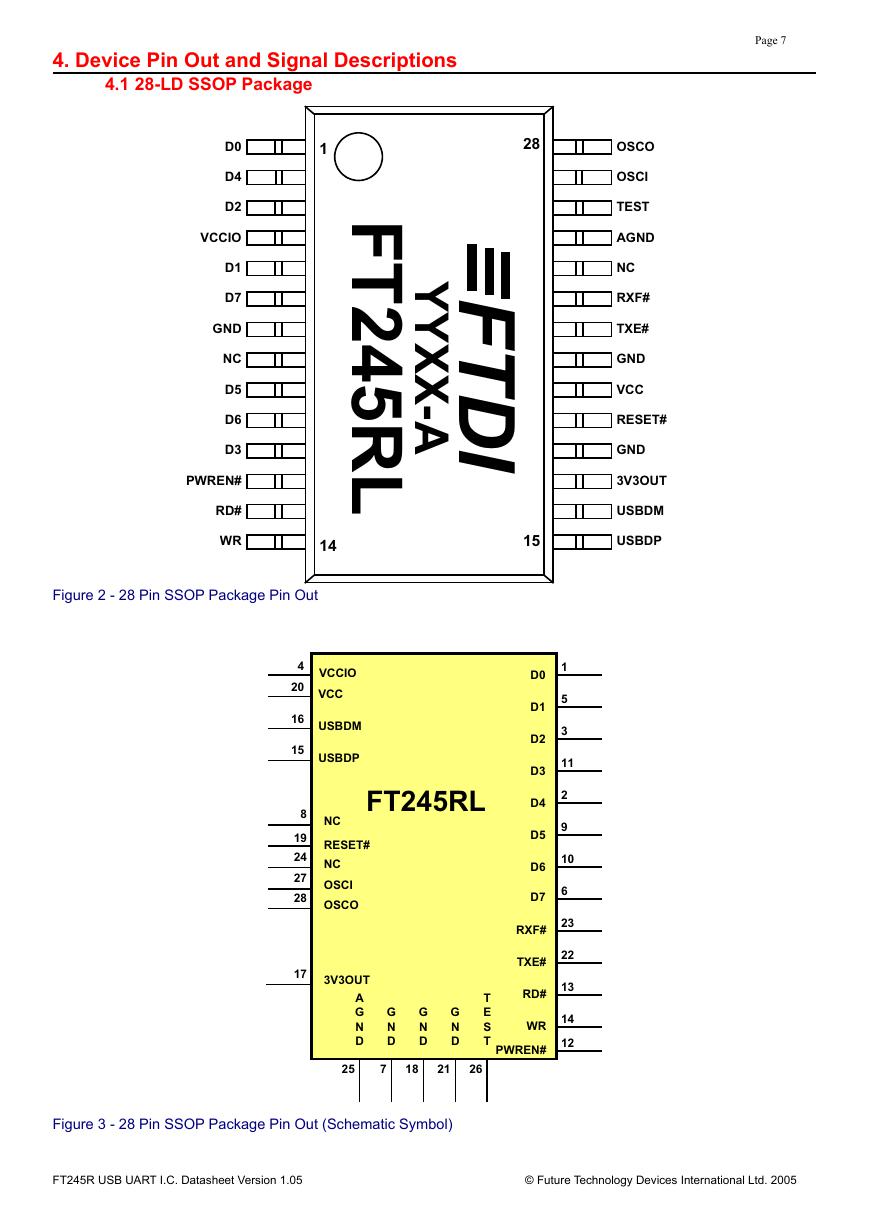
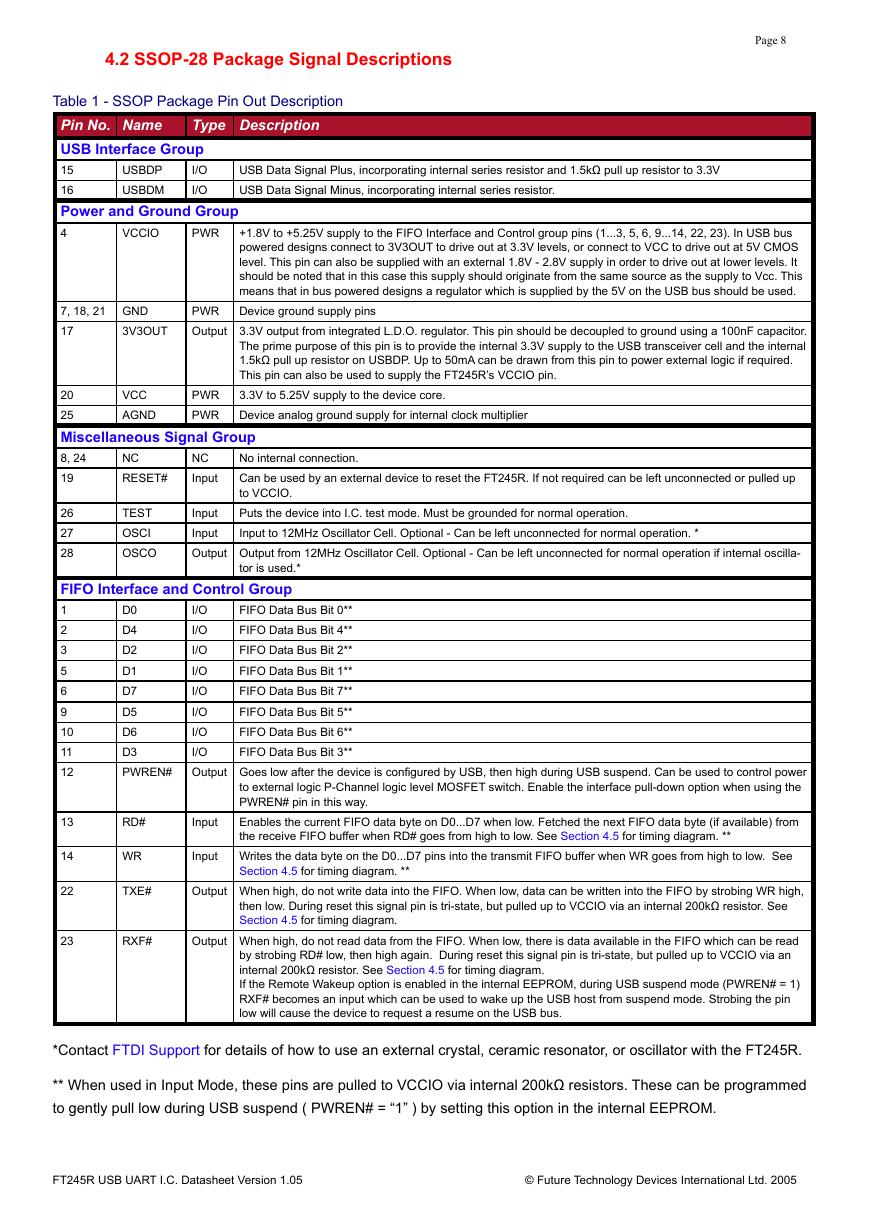








 V2版本原理图(Capacitive-Fingerprint-Reader-Schematic_V2).pdf
V2版本原理图(Capacitive-Fingerprint-Reader-Schematic_V2).pdf 摄像头工作原理.doc
摄像头工作原理.doc VL53L0X简要说明(En.FLVL53L00216).pdf
VL53L0X简要说明(En.FLVL53L00216).pdf 原理图(DVK720-Schematic).pdf
原理图(DVK720-Schematic).pdf 原理图(Pico-Clock-Green-Schdoc).pdf
原理图(Pico-Clock-Green-Schdoc).pdf 原理图(RS485-CAN-HAT-B-schematic).pdf
原理图(RS485-CAN-HAT-B-schematic).pdf File:SIM7500_SIM7600_SIM7800 Series_SSL_Application Note_V2.00.pdf
File:SIM7500_SIM7600_SIM7800 Series_SSL_Application Note_V2.00.pdf ADS1263(Ads1262).pdf
ADS1263(Ads1262).pdf 原理图(Open429Z-D-Schematic).pdf
原理图(Open429Z-D-Schematic).pdf 用户手册(Capacitive_Fingerprint_Reader_User_Manual_CN).pdf
用户手册(Capacitive_Fingerprint_Reader_User_Manual_CN).pdf CY7C68013A(英文版)(CY7C68013A).pdf
CY7C68013A(英文版)(CY7C68013A).pdf TechnicalReference_Dem.pdf
TechnicalReference_Dem.pdf